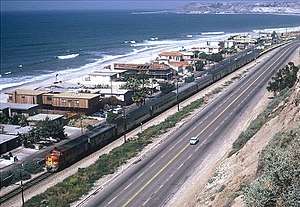Surf Line

The Surf Line is a railroad line that runs from San Diego north to Orange County along California's Pacific Coast. It was so named because much of the line was near the Pacific Ocean, within less than 100 feet (30 m) in places. The tracks are now owned by the Southern California Regional Rail Authority and the North County Transit District, and hosts Metrolink's Orange County Line and Inland Empire–Orange County Line, the San Diego Coaster, and Amtrak Pacific Surfliner passenger trains. The BNSF Railway operates freight over the line using trackage rights.
History
Construction of the Surf Line between Los Angeles and San Diego began on October 12, 1880, with the organization of the California Southern Railroad Company. On January 2, 1882, the California Southern commenced passenger and freight service between National City and Fallbrook Junction, just north of Oceanside.[1] From Oceanside the line turned northeast for a winding route through the Temecula Canyon, and was finished on August 21, 1882.[2]
The line became part of the Atchison, Topeka and Santa Fe Railroad's transcontinental rail line in 1885 via an extension of the California Southern from Colton north over the Cajon Pass to Barstow. From 1886 to 1888, the Riverside, Santa Ana and Los Angeles Railway built a branch from Highgrove southwest via Riverside to Santa Ana and from Orange (just north of Santa Ana) northwest to Los Angeles. Also in 1888 the San Bernardino and San Diego Railway completed its line from Oceanside north to Santa Ana, completing what was originally called the Los Angeles-San Diego Short Line. The now-downgraded old route was destroyed by floods in 1891 and the new line, later named the Surf Line, was now the only line to San Diego from the north.
In 1910, the Fullerton and Richfield Railway built a short cutoff of the San Bernardino-Los Angeles route from Atwood west to Fullerton, giving the Surf Line its northern terminus of Fullerton.
For much of the 20th century, the Surf Line (officially, the Fourth District of the Los Angeles Division[3]) was to the Santa Fe what the New York City–Philadelphia corridor was to the Pennsylvania Railroad. Daily traffic could reach a density of ten trains (each way) during the summer months. The route hosted AT&SF San Diegan passenger trains, renamed the Pacific Surfliner by Amtrak in 2000.[4]
The Santa Fe installed Centralized traffic control in 1943–1944 which increased capacity on the line.[5] In the 1990s the SCRRA (Southern California Regional Rail Authority, also known as Metrolink) and the San Diego Northern Railway (Coaster) bought the sections of the line in Orange and San Diego Counties and began operating commuter trains.[6]
Historic station stops
These are not all the stations that currently operate. Many of these stations no longer exist (i.e. Linda Vista) and new ones have opened (i.e. Sorrento Valley). For a list of stations that currently operate, see the articles for Metrolink's Orange County Line and the Coaster.
Santa Fe Los Angeles Division: Fourth District
See also
- The Coast Line, continuing north from Los Angeles to San Francisco. It is owned by the SCRRA between Los Angeles and Moorpark, and Union Pacific from Moorpark onwards.
Notes
- ↑ Duke 1995, p. 50
- ↑ Duke 1995, pp. 53-54
- ↑ Richardson 2005, p. 38
- ↑ Gabbard, Dana (September 24, 2012). "History of the Surfliner, LOSSAN and a Look at Pending Legislation". StreetsBlog LA. OpenPlans. Retrieved 2015-03-27.
- ↑ Jordan 2004, p. 69
- ↑ Stein, Mark A. and Perlman, Jeffrey A. (June 19, 1992) "Santa Fe, Transit Officials Reach Rail Deal : Commuting: The $500-million agreement for 336 miles of track means expanded O.C. passenger service." Los Angeles Times
References
- Duke, Donald (1995). Santa Fe...The Railroad Gateway to the American West. 1. San Marino, CA: Golden West Books. ISBN 0-8709-5110-6. OCLC 32745686.
- Jordan, Keith (1996). "The Surf Line 1940–1950". The Warbonnet. 2 (2): 4–24.
- Jordan, Keith (1996). "The Surf Line Part II: 1950–1965". The Warbonnet. 2 (4): 11–24.
- Jordan, Keith (August 2004). "Santa Fe Surf Line, 1940" (PDF). Trains. 64 (8): 64–69. ISSN 0041-0934.
- Richardson, Don (June 2005). "The secret borax train" (PDF). Classic Trains. 6 (2): 36–39.
- California Southern Railway History